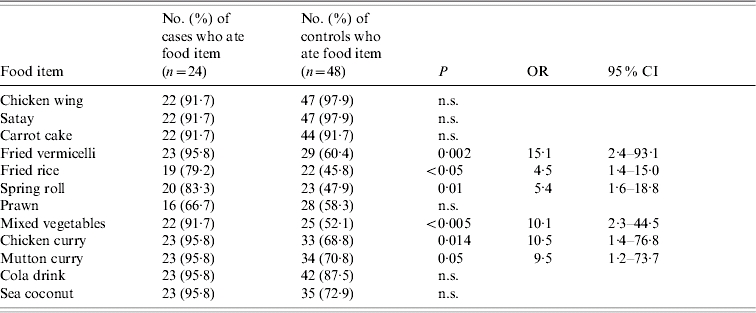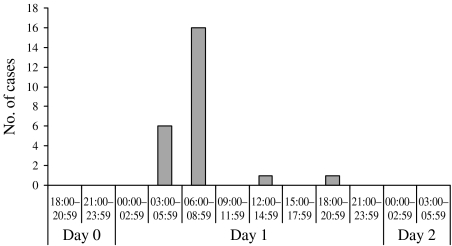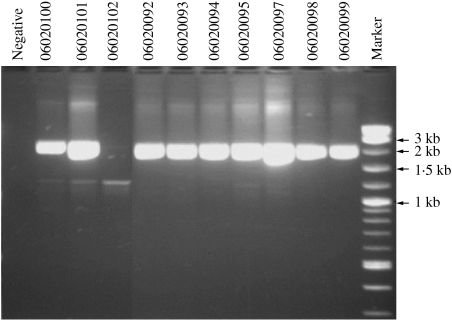SUMMARY
A gastroenteritis outbreak occurred in a military camp where a laboratory and epidemiological investigation was carried out. The early onset of symptoms indicated probable food contamination with Clostridium perfringens. Stool samples collected from affected patients were tested within 4 h via real-time polymerase chain reaction (PCR) for the presence of the C. perfringens plc gene. Ten out of the 12 stool samples were positive. Confirmation of the molecular test results was carried out by enumeration of C. perfringens in stool by culture and shown to be in excess of 106 spores/g stool. The isolates obtained from culture were further analysed by PCR for the presence of the chromosomal enterotoxin (cpe) gene. Based on the clinical symptoms, epidemiological and laboratory investigations, C. perfringens was implicated as the aetiological agent. The ability to conduct real-time PCR analysis greatly shortens the time to diagnosis and allows for preventive and control measures to be effected quickly.
INTRODUCTION
Clostridium perfringens is a common cause of food-poisoning outbreaks. The disease is characterized by diarrhoea and abdominal cramps without fever. Symptoms typically begin 7–15 h after consumption of food contaminated with high concentrations of this organism [1, 2]. As it is common for C. perfringens spores to be present in small numbers in human stool specimens, epidemiological criteria have been established to confirm if C. perfringens is the aetiological agent in outbreaks. This includes a median stool C. perfringens spore count of >106/g in ill persons [1, 2] and identification of C. perfringens of the same serotype in most ill persons [2]. This, however, is not a rapid process. Detection in stool samples of C. perfringens enterotoxin (CPE) has also been suggested to be the definitive method of implicating this organism as the cause of illness [3], with most human disease-associated food isolates generally having a chromosomally located cpe gene [4].
Epidemiologically, most C. perfringens diarrhoeal outbreaks are due to consumption of contaminated meat products, especially chicken and beef [5]. In this paper, we report an investigation into a diarrhoea outbreak, using a combination of polymerase chain reaction (PCR) and classical microbiological methods, the results of both implicate C. perfringens as the aetiological agent.
MATERIALS AND METHODS
Criteria for cases and controls
The outbreak occurred in a military camp and was reported to the Preventive Medicine Branch of the Singapore Armed Forces Medical Corps, which implemented an active surveillance for acute diarrhoea. All cases of diarrhoea that presented during the period of active surveillance were included in this study. Controls were randomly selected from personnel from the same camp and who attended the same dinner event as the cases but were not ill with diarrhoea.
Epidemiological investigation
A food survey was conducted among the cases and controls. Records of the types of food served in the military camp for up to 3 days prior to the outbreak was obtained and included in the survey. Inspections of the food and drinks preparation area in the military cookhouse were conducted and cookhouse staff screened for diarrhoeal pathogens via stool culture. Stool samples were collected from affected individuals and sent for laboratory analysis. No food samples were available for laboratory analysis.
Extraction of DNA from stool
A total of 12 stool samples were received and sent for laboratory analysis. Stool samples (0·5 ml) are homogenized in 1 ml sterile saline. The homogenate was then centrifuged at 400 g for 2 min to pellet stool debris. The supernatant was transferred to a new centrifuge tube and centrifuged at 10 000 g for 2 min to pellet bacteria following which the supernatant was discarded. The bacteria cells were then resuspended in 180 μl of ATL buffer (QIAamp DNA mini-kit, Qiagen, Hilden, Germany) and DNA extracted using the tissue protocol of the QIAamp DNA mini-kit.
Detection of C. perfringens using plc real-time PCR
Real-time PCR format was chosen to analyse these samples directly due to its speed and reduced risk of cross contamination. The C. perfringens plc real-time PCR assays used were developed in-house using FRET probes and targeted the α-toxin gene. Primers and probes for the C. perfringens plc-specific PCR were cp-plc-fp (5′-TTTGTGCCACGCTAGT-3′), cp-plc-rp (5′-TCCCCTGTGTCAGGTAT-3′), cp-plc-L (5′-GCCTATGGGCTGGGGTAT-fluorescein-3′) and cpl-plc-R (5′-LCRed640-ACTAAAGTCTACGCTTGGGATGG-p-3′). PCR was conducted on a LightCycler apparatus (Roche Applied Science, Mannheim, Germany) using the following PCR profile: 2 min at 95°C followed by 45 cycles of 0 s at 95°C, 5 s at 55°C and 20 s at 72°C. The PCR mix consisted of 1× PCR buffer, 0·5 μm primers, 0·2 μm probes, 4 mm MgCl2, 0·2 mm dNTP, 0·5 U platinum Taq DNA polymerase (Invitrogen Corp., Carlsbad, CA, USA) and 1·5 μl of template in a final volume of 10 μl. The assays have been internally validated against 39 other bacterial species for specificity including C. botulinum, C. difficile and C. tetani, and tested for sensitivity using 28 C. perfringens strains (results not shown).
Enumeration of C. perfringens in stool
As C. perfringens is a commensal in the stool of some normal healthy subjects, we sought microbiological confirmation to support indication that C. perfringens was the aetiological agent of the outbreak. Ten of the 12 stool samples were further analysed by quantitative culture of spores [1]. Quantitative stool spore counts for C. perfringens were performed using the method described by Hauschild [1]. Briefly, stool samples were homogenized (1 g stool in 9 ml sterile saline) and divided in two aliquots. One aliquot was heated at 80°C for 10 min. A total of 10 μl of each aliquot was plated onto blood agar plates with polymyxin B sulphate (30 000 IU/l) and kanamycin sulphate (12 mg/l). The plates were then incubated anaerobically at 37°C overnight, checked for growth and scored for number of colony-forming units (c.f.u.).
C. perfringens enterotoxin (CPE) detection and genotyping of C. perfringens isolates
Total genomic DNA from pure C. perfringens isolates was extracted using the QIAamp DNA mini-kit (Qiagen) according to the manufacturer's recommendations. The CPE genotyping PCR was set up and analysed according to the protocol established by Wen et al. [6].
RESULTS
The diarrhoeal outbreak occurred in a military camp in February 2006 where over a period of 2 days, 24 personnel became ill with diarrhoea. Symptoms were generally mild with fever observed in only two cases. The onset times of diarrhoeal illness in the cases identified through active surveillance is shown in Figure 1. All cases presented within the same day from 05:00 to just after 19:00 hours. The predominant symptom was diarrhoea (100%), while nausea, fever and vomiting were less common. No case presented with vomiting or bloody diarrhoea. The symptoms were self-limiting and resolved within a day for all cases with only supportive treatment.
Fig. 1.
Number of reported diarrhoeal cases based on time of onset of symptoms.
Epidemiological investigations indicated that all affected personnel participated in a dinner event on the evening before symptoms appeared, giving rise to an estimated incubation period of 10–24 h, with an average of 12 h. A food survey was conducted and results are shown in the Table. Analysis of the food survey shows that the probable implicated food includes the two meat curry dishes as well as the mixed vegetables and fried vermicelli.
Table.
A survey of food items consumed by cases and controls at the dinner event

n.s., Not significant; OR, odds ratio; CI, confidence interval.
All 12 (100%) stool samples were positive for α-toxin (plc) gene detection via PCR (Fig. 2). C. perfringens was isolated from all 10 stool specimens examined in excess of 106 spores/g stool. The identity of the isolates was re-confirmed as being C. perfringens via PCR. PCR analysis on these isolates was also positive for the presence of the chromosomal cpe gene (Fig. 3) for enterotoxin production except isolate 06020102, further implicating C. perfringens as the causative agent in the gastroenteritis outbreak.
Fig. 2.
C. perfringens plc PCR of DNA from 12 stool samples with 12 positive results reflected.
Fig. 3.
CPE typing PCR. Presence of a 2·1 kb band depicts the presence of the chromosomal cpe gene while the presence of a 3·3 kb band would have indicated a plasmid-borne cpe gene.
DISCUSSION
Based on clinical symptoms and epidemiological investigations, C. perfringens was suspected to be the causative pathogen. Specific real-time PCR assays developed in-house on the Roche LightCycler™ (Roche Applied Science) for the detection of C. perfringens α-toxin was first used for screening due to speed of analysis. These assays were previously developed primarily for the detection of gas gangrene or clostridial myonecrosis, both of which are associated with C. perfringens type A strains [7]. In gas gangrene, θ-toxin together with α-toxin, modulate the host inflammatory response, causing leukocyte accumulation within blood vessels and inhibiting the normal influx of phagocytic cells into infected host tissue [7, 8]. We have found this semi-quantitative PCR assay to be suitable for rapidly screening stool samples for the potential presence of large numbers of C. perfringens in a gastroenteritis outbreak. Internal validation of these PCR assays against 84 normal as well as non-C. perfringens-causing gastroenteritis stool samples has shown that only 73 (87%) were negative while the remaining 11 samples (13%) were weakly positive (results not shown).
Within 4 h of receipt of the stool samples, a preliminary real-time PCR assay specific for C. perfringens, was completed with positive findings. The identification of C. perfringens as the causative pathogen was strongly suggestive at this stage of the investigation as the PCR was positive among most of the affected personnel. Furthermore, although C. perfringens is a known commensal of the human gut, the levels of C. perfringens in the stool of healthy individuals are usually below the limit of detection for direct PCR without prior enrichment. The real-time PCR result thus allowed the epidemiological investigation and implementation of outbreak response measures to be guided by the probable aetiology.
We also sought further evidence to support the PCR result since there are only a few reports in the literature on the use of a molecular approach to identify C. perfringens as the aetiological agent of a diarrhoeal outbreak. Quantitative spore culture using selective media at anaerobic conditions was employed to enumerate C. perfringens spores in the stool samples. Further confirmation that the cultured organisms were C. perfringens was achieved via the detection of cpe genes in the isolates using conventional PCR. This latter PCR could not be performed on nucleic acid extracted directly from the stool samples due to specificity problems associated with commensal gut microorganisms (results not shown).
Based on the food survey findings, the implicated food in this outbreak is likely to be either the vegetable dishes or the meat curry dishes. C. perfringens in meat dishes, particularly stews, is a well known cause of outbreaks although contamination of vegetable dishes by this bacterium has also been previously reported [9]. The food caterer involved in this outbreak cooked the food at a kitchen outside the military camp. This food was then transported to the camp and reheated before it was served. Contamination of the food with a diarrhoeal-causing bacterium could thus have occurred in the caterer's kitchen during the preparation stages. Unfortunately, we were not able to carry out microbiological tests on any food samples as these were discarded after the meal.
The outbreak investigation highlighted how specific real-time PCR, based on available epidemiological data and clinical symptoms, can be utilized to rapidly identify the causative pathogen. Knowledge of the aetiological agent can guide the implementation of specific outbreak control measures. Without knowing the aetiology of the outbreak, public health measures would need to include all possibilities, leading to increased time spent on epidemiological investigation and the financial cost associated with prolonged investigations.
DECLARATION OF INTEREST
None.
REFERENCES
- 1.Hauschild AHW. Criteria and procedures for implicating Clostridium perfringens in foodborne outbreaks. Canadian Journal of Public Health. 1975;66:388–392. [PubMed] [Google Scholar]
- 2.CDC Atlanta, GA, USA: 1985. . Foodborne disease outbreaks annual summary, 1982. Centers for Disease Control, [Google Scholar]
- 3.Birkhead G et al. Characterization of an outbreak of Clostridium perfringens food poisoning by quantitative fecal culture and fecal enterotoxin measurement. Journal of Clinical Microbiology. 1988;26:471–474. doi: 10.1128/jcm.26.3.471-474.1988. [DOI] [PMC free article] [PubMed] [Google Scholar]
- 4.Siragusa GR et al. Molecular subtyping of poultry-associated type A Clostridium perfringens isolates by repetitive-element PCR. Journal of Clinical Microbiology. 2006;44:1065–1073. doi: 10.1128/JCM.44.3.1065-1073.2006. [DOI] [PMC free article] [PubMed] [Google Scholar]
- 5.CDC Atlanta, GA, USA: 2004. . Foodborne disease outbreaks 2004 summary statistics. Centers for Disease Control, [Google Scholar]
- 6.Wen QY, Miyamoto K, McClane BA. Development of a duplex PCR genotyping assay for distinguishing Clostridium perfringens Type A isolates carrying chromosomal enterotoxin (cpe) genes from those carrying plasmid-borne enterotoxin (cpe) genes. Journal of Clinical Microbiology. 2003;41:1494–1498. doi: 10.1128/JCM.41.4.1494-1498.2003. [DOI] [PMC free article] [PubMed] [Google Scholar]
- 7.Awad MM et al. Synergistic effects of alpha-toxin and perfringolysin O in Clostridium perfringens-mediated gas gangrene. Infection and Immunity. 2001;69:7904–7910. doi: 10.1128/IAI.69.12.7904-7910.2001. [DOI] [PMC free article] [PubMed] [Google Scholar]
- 8.O'Brien DK, Melville SB. Effects of Clostridium perfringens Alpha-toxin (PLC) and Perfringolysin O (PFO) on cytotoxicity to macrophages, on escape from the phagosomes of macrophages, and on persistence of C. perfringens in host tissues. Infection and Immunity. 2004;72:5204–5215. doi: 10.1128/IAI.72.9.5204-5215.2004. [DOI] [PMC free article] [PubMed] [Google Scholar]
- 9.Roach RL, Sienko DG. Clostridium perfringens outbreak associated with minestrone soup. American Journal of Epidemiology. 1992;136:1288–1291. doi: 10.1093/oxfordjournals.aje.a116437. [DOI] [PubMed] [Google Scholar]





